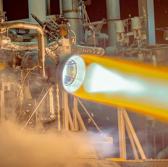Aerojet Rocketdyne has conducted hot-fire tests on a full-scale thrust chamber assembly the company built using a three-dimensional printing method that incorporated selective laser melting technology.
has conducted hot-fire tests on a full-scale thrust chamber assembly the company built using a three-dimensional printing method that incorporated selective laser melting technology.
The company said Monday that the Defense Production Act Title III program management office at Wright-Patterson Air Force Base facilitated tests of the 3D-printed thrust chamber for the RL10 rocket engine.
RL10’s copper thrust chamber will replace the current RL10C-1 model that uses traditional manufacturing techniques to form drawn, hydroformed stainless steel tubes into an engine chamber.
Aerojet Rocketdyne noted that the use of 3D technology can also open opportunities  for engine manufacturers to build and design new features that will help boost heat transfer capacity.
“Now that we have validated our approach with full-scale testing of a 3-D printed injector and copper thrust chamber, we are positioned to qualify a new generation of RL10 engines at a much lower cost,” said Christine Cooley, RL10 program director at Aerojet Rocketdyne.
“With the next generation of RL10 engines, we aim to maintain the reliability and performance that our customers have come to expect, while at the same time making the engine more affordable to meet the demands of today’s marketplace.”
The company also plans to apply 3D printing technology to produce RS-25 engines designed for deep-space exploration missions and AR1 booster engines as a potential replacement for the Russian RD-180 engines currently used in U.S. military satellite launches.




